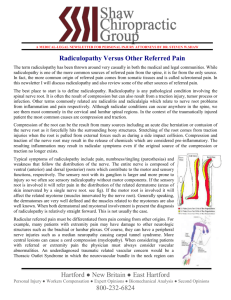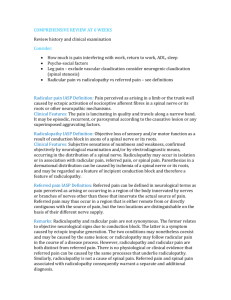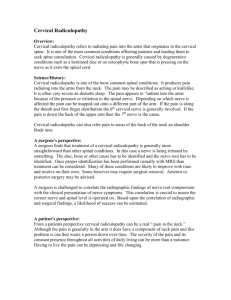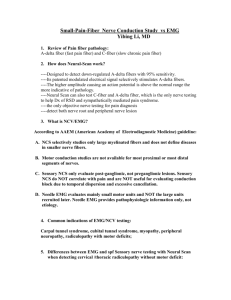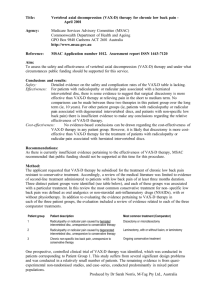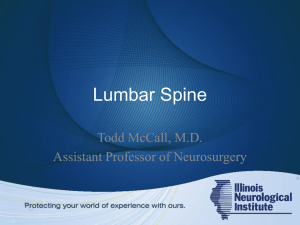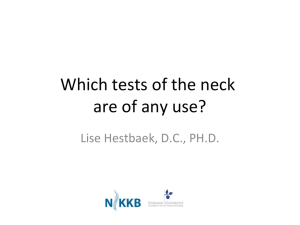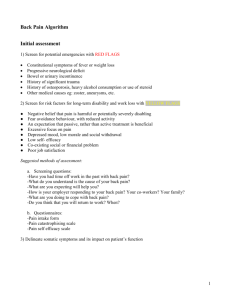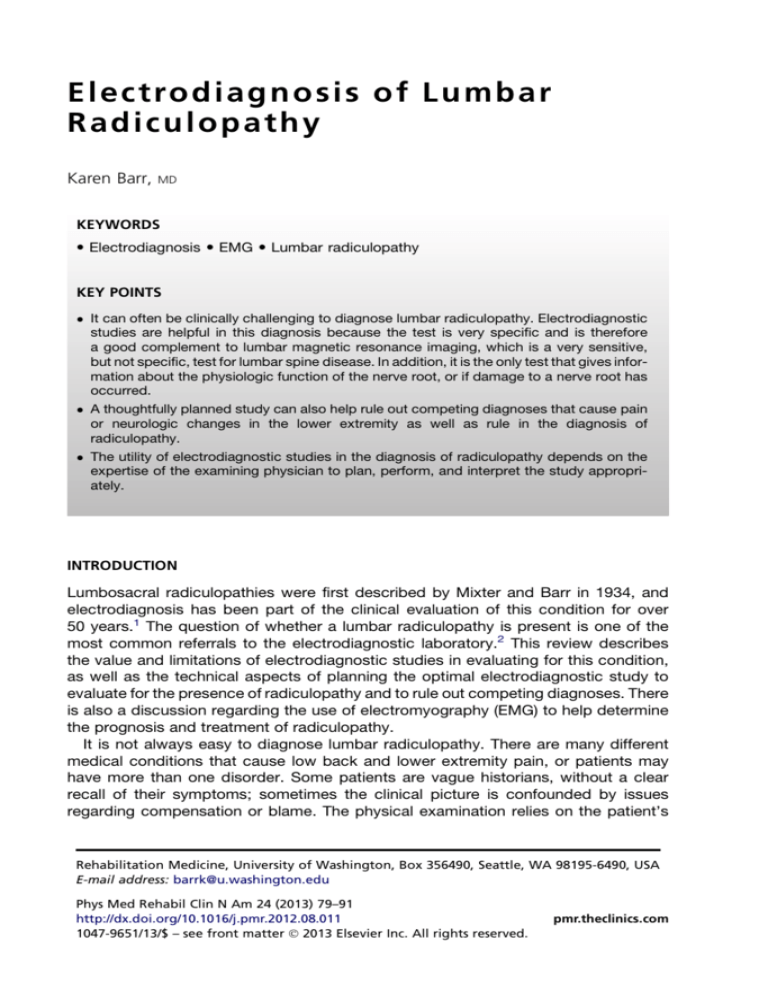
E l e c t ro d i a g n o s i s o f L u m b a r
Radiculopathy
Karen Barr,
MD
KEYWORDS
Electrodiagnosis EMG Lumbar radiculopathy
KEY POINTS
It can often be clinically challenging to diagnose lumbar radiculopathy. Electrodiagnostic
studies are helpful in this diagnosis because the test is very specific and is therefore
a good complement to lumbar magnetic resonance imaging, which is a very sensitive,
but not specific, test for lumbar spine disease. In addition, it is the only test that gives information about the physiologic function of the nerve root, or if damage to a nerve root has
occurred.
A thoughtfully planned study can also help rule out competing diagnoses that cause pain
or neurologic changes in the lower extremity as well as rule in the diagnosis of
radiculopathy.
The utility of electrodiagnostic studies in the diagnosis of radiculopathy depends on the
expertise of the examining physician to plan, perform, and interpret the study appropriately.
INTRODUCTION
Lumbosacral radiculopathies were first described by Mixter and Barr in 1934, and
electrodiagnosis has been part of the clinical evaluation of this condition for over
50 years.1 The question of whether a lumbar radiculopathy is present is one of the
most common referrals to the electrodiagnostic laboratory.2 This review describes
the value and limitations of electrodiagnostic studies in evaluating for this condition,
as well as the technical aspects of planning the optimal electrodiagnostic study to
evaluate for the presence of radiculopathy and to rule out competing diagnoses. There
is also a discussion regarding the use of electromyography (EMG) to help determine
the prognosis and treatment of radiculopathy.
It is not always easy to diagnose lumbar radiculopathy. There are many different
medical conditions that cause low back and lower extremity pain, or patients may
have more than one disorder. Some patients are vague historians, without a clear
recall of their symptoms; sometimes the clinical picture is confounded by issues
regarding compensation or blame. The physical examination relies on the patient’s
Rehabilitation Medicine, University of Washington, Box 356490, Seattle, WA 98195-6490, USA
E-mail address: barrk@u.washington.edu
Phys Med Rehabil Clin N Am 24 (2013) 79–91
http://dx.doi.org/10.1016/j.pmr.2012.08.011
1047-9651/13/$ – see front matter Ó 2013 Elsevier Inc. All rights reserved.
pmr.theclinics.com
80
Barr
cooperation and may be difficult to interpret. Because of this, it is common for patients
to undergo further testing to confirm or rule out this diagnosis. From an evidencebased medicine perspective, it can be difficult to assess the value of these tests,
because there is no one gold standard for the diagnosis of lumbar radiculopathy.
Therefore, in both research and the clinic, a combination of history, physical examination, imaging, and electrodiagnostic testing is used to come to a diagnosis.
MAGNETIC RESONANCE IMAGING VERSUS ELECTRODIAGNOSTIC STUDIES IN
DIAGNOSING LUMBAR RADICULOPATHY
Most radiculopathies are caused by root compression, most commonly from intervertebral disk disease or other degenerative changes of the spinal column, such as ligamentous hypertrophy or the bony changes that accompany osteoarthritis. Other
compressive lesions can less commonly cause radiculopathy, such as tumors and
cysts. Magnetic resonance imaging (MRI) is exquisitely sensitive in detecting these
anatomic changes. However, MRI often shows disk disease and other degeneration
in asymptomatic people. Lumbar disk protrusions can be seen in as high as 67% of
asymptomatic patients older than age 60, and more than 20% have lumbar central
stenosis.3 Therefore, MRI is very sensitive in detecting anatomic changes that could
cause a radiculopathy but does not give any information about nerve function or
whether these anatomic changes could be a source of symptoms.
There are other causes of radiculopathy besides nerve root compression, and MRI
would not be helpful in the diagnosis of these types of radiculopathy. Motor radiculopathy can be seen in patients from varicella zoster virus, even in the absence of skin
lesions.4 Inflammatory mediator cytokines, perhaps from regional disk disease or
other factors, can be a source of neuropathic pain and a “chemical radiculitis” without
evidence of nerve root compression.5,6
STRENGTHS OF ELECTRODIAGNOSTIC TESTING FOR RADICULOPATHY
Studies have found that needle EMG is very specific in the diagnosis of lumbar radiculopathy when the appropriate electrodiagnostic criteria are used. For that reason
clinically EMGs are commonly performed to rule in a radiculopathy, particularly in
the following situations:
1. To determine if the structural changes seen on MRI are the common finding of an
asymptomatic abnormality or are actually causing physiologic abnormalities in the
nerve root
2. To determine the most likely affected level if clinical symptoms and imaging levels
do not match
3. To look for physiologic evidence if noncompressive radiculopathies are suspected
4. To determine prognosis related to axonal loss
5. To search for other causes of neurologic symptoms
6. Electrodiagnostic studies for radiculopathy are rarely false positive: if an EMG
shows evidence of a radiculopathy, the patient almost certainly has one. When
the criteria used for diagnosis are the presence of positive sharp waves and fibrillation in 1-limb muscle plus lumbar paraspinal muscles at the corresponding level,
or in 2-limb muscles innervated by the same nerve root, it is 100% specific, both in
asymptomatic patients and in those patients with low back pain and sciatica. If
evidence of either acute changes or chronic denervation (as demonstrated by
more than 30% of motor units are polyphasic, have large amplitude, and have
increased duration in a study that uses monopolar needles) is used as the
Electrodiagnosis of Lumbar Radiculopathy
electrodiagnostic criteria, then specificity decreases, but still remains in the range
of 81- nearly 100%, depending on the level tested.7
LIMITATIONS OF ELECTRODIAGNOSTIC STUDIES BECAUSE OF THE NATURE OF
RADICULOPATHY
In contrast to the strength of very high specificity, one of the biggest limitations of electrodiagnostic testing for radiculopathy is that sensitivity is not that high. The exact
sensitivity cannot be calculated, because of the lack of a gold standard, but it is often
noted that a patient may clinically seem to have a radiculopathy that electrodiagnostic
testing is unable to diagnose. It is also possible that an electrodiagnostician could
determine that a radiculopathy is present, but be unable to ascertain the exact root
level involved. Some reasons for this relative insensitivity follow.
WHY A PATIENT COULD HAVE A RADICULOPATHY AND STILL HAVE A NORMAL
ELECTRODIAGNOSTIC STUDY
1. Inability to detect pure sensory radiculopathies: Clinically, most patients present
with either purely sensory complaints (such as pain, parasthesias, or numbness)
or primarily sensory complaints with some minimal complaints of weakness.
However, because the site of nerve injury is proximal to the dorsal root ganglion
in radiculopathies, sensory nerve conduction studies will be normal.2 Therefore,
there is no way for electrodiagnostic studies to evaluate these purely sensory nerve
problems. Because there is no gold standard for the diagnosis of radiculopathy, it is
unknown what percentage of radiculopathies is purely sensory.
2. Subtotal root involvement is the norm in lumbar radiculopathies: This root involvement may include demyelination, which would not cause most of the characteristic
changes evaluated for on needle EMG, or limited axonal loss that goes undetected
because only a few axons are involved. Therefore even in the presence of a motor
radiculopathy, nerve fibers supplying much of the muscle are spared.2
3. If denervation is balanced with reinnervation, or the denervation is old, no fibrillations will be seen, and the denervation will be missed.5
WHY A PATIENT COULD HAVE A RADICULOPATHY, BUT THE LEVEL OF NERVE INJURY
CANNOT BE DETERMINED
Imprecision of Myotomal Maps
Many myotomal maps have been published, but the primary root innervation of many
muscles remains unclear. Besides a lack of consensus in this area, there is considerable individual variation in the innervation of individual muscles.8 Because of this, if
needle EMG changes are found in a muscle, the examining physician cannot say
with 100% certainty what root level innervates that muscle; the examiner can only
state what is thought to be the usual level for a typical patient.
Difficulty with Precise Localization of the Lesion in Patients with High Lumbar
Radiculopathy
There are 2 issues that make this a difficult condition to diagnose precisely with electrodiagnostic testing. One issue is that lesions of L2, L3, and L4 radiculopathy have
very extensive myotomal overlap, so it is often not possible to separate out which
of these specific roots is the cause of the electrodiagnostic findings. The second issue
is that it is often difficult to separate out plexopathy from radiculopathy at these levels.
There are 2 main reasons for this. One is that, unlike brachial plexopathies, there are
no good, reliable sensory nerve conduction studies for the nerves that arise for the
81
82
Barr
upper lumbar plexus. If there were, this would give evidence to the electrodiagnostician that the problem is the plexus rather than the nerve root. The second reason is
the limitation of paraspinal muscles in separating plexopathy from radiculopathy. In
theory, abnormal paraspinal muscles would be expected in radiculopathy and would
not be present with plexopathy. However, in reality, sometimes the paraspinal
muscles are normal, and a radiculopathy is present; sometimes the paraspinal
muscles are abnormal for reasons unrelated to radiculopathy.
Difficulty with Precise Localization of the Lesion in Patients with Lower Lumbar and
Sacral Radiculopathies
Because of the anatomy of this region, there are many locations where the nerve root
may be injured by a ruptured disk or other compressive force. For example, a disk
herniation between the L4 and L5 vertebral bodies (which is the most common level)
can affect the L4 root if it is a far lateral herniation, the L5 root if it is a posterior lateral
herniation, and the S1–S4 roots if it is a central herniation. Within the cauda equina,
roots are packed closely together so it is common for bilateral, multiroot lesions to
be found in lumbar central stenosis.2
ANOTHER STUDY LIMITATION: EXAMINER EXPERTISE
Although these studies may seem to be objective; in reality, just as in other diagnostic
tests, the skill of the physician performing and interpreting the study is the biggest
factor in obtaining accurate results. This issue was studied by Kendall and Werner
by comparing the diagnostic impressions of 6 cases of lumbar radiculopathy of an
unblinded electromyographer with the impressions of the recorded study by a blinded
resident or faculty electromyographer.9 They found that the overall diagnostic agreement was only 46.9%. Faculty was twice as likely to agree on the final diagnosis as
residents, demonstrating that extensive training is necessary to perform these studies
accurately. Another study that looked at interrater reliability of needle EMG findings in
lumbar radiculopathy used only expert examiners and compared the results of
unblinded with blinded electrodiagnosticians. This study found an outstanding overall
diagnostic impression agreement of greater than 90% between the unblinded and
blinded examiners.10
PLANNING THE ELECTRODIAGNOSTIC STUDY
As mentioned earlier, the usefulness of electrodiagnostic testing for radiculopathy
depends directly on the skills of the physician performing the study, and this applies
to study planning as well as study interpretation. In general, there are 2 purposes of
the electrodiagnostic study: to determine whether there is electrodiagnostic evidence
of a radiculopathy, and to rule in or out competing diagnoses for the patient’s
symptoms.
The first part of this section addresses study planning in general. The second part
addresses using electrodiagnostic studies to help in sorting out competing clinical
diagnoses.
NEEDLE ELECTRODE EXAMINATION
The most important part of the electrodiagnostic testing to diagnose a radiculopathy is
needle EMG. Other components may be helpful, but they are used primarily to rule in
or out competing diagnoses that could explain all or part of the patient’s symptoms.
The presence of positive sharp waves and fibrillations in a myotomal distribution is
Electrodiagnosis of Lumbar Radiculopathy
the most reliable evidence of radiculopathy. Many electrodiagnosticians think there is
a window of time when these acute changes are seen: They most likely first appear in
the paraspinal muscles by about 7 days, but may not be seen in distal muscles for 5 or
6 weeks. Total myotomal involvement is rare—often many muscles within a myotome
never show damage. If no further nerve damage occurs, these spontaneous changes
generally disappear by about 9 months.2 This limited duration of findings has also
been shown in animal studies.6 Other spontaneous activity, such as fasciculation
potentials and complex repetitive discharges, are sometimes present and may help
make the diagnosis. Abnormal motor unit action potential recruitment in a neurogenic
pattern may be seen. Chronic neurogenic motor unit action potential changes are
frequent in chronic radiculopathies, but if this alone is used for making the diagnosis,
there is a significantly higher incidence of false positives, and many electrodiagnostic
physicians think that this makes it unacceptable sole diagnostic criteria (Fig. 1).
WHAT MUSCLES TO CHOOSE TO STUDY FOR NEEDLE EMG
The best designed needle study is able to identify the level of radiculopathy, without
causing unnecessary discomfort to the patient by testing unnecessary muscles. It
also rules out another cause for an abnormal needle examination other than
radiculopathy.
Principles of muscle selection include the following:
1. Several muscles with the same root innervations, but different peripheral nerves,
should be tested.
2. Other muscles in the region and other muscles with the same peripheral nerve
but different root levels should be tested, to rule out other causes of abnormal
Fig. 1. Lower extremity myotomal chart shows major and significant nerve root innervation
of lower extremity muscles. Boxes shaded in green represent a dominant contribution,
whereas boxes shaded in yellow represent a significant contribution. Minor contributions
are not shown.
83
84
Barr
needle study, such as myopathy length-dependent peripheral neuropathy, or
a mononeuropathy.
This framework for muscle selection still raises many questions: are some muscles
more likely to be abnormal than others within a given root? Are there certain muscles
that have less intersubject variation in root innervations, or more dominant root innervations, so that the examiner would be more confident that an abnormal muscle
corresponded to a specific root?
One way of attempting to answer this question is to compare electrodiagnostic findings of patients with MRI evidence and surgically verified single-level spinal nerve root
lesions as wasperformed by Tsao and colleagues.11 In this study, 45 patients had
positive electrodiagnostic studies, positive preoperative MRI, and surgically
confirmed root lesions. Their findings are summarized below.
L2 and L3 Radiculopathy
There were very few patients in the study with L2 and L3 radiculopathies, and no
particular pattern of muscle involvement was found that could distinguish one of these
levels from another, most likely because of the marked overlap of muscle innervations
in the anterior thigh. Both patients had abnormal iliacus, adductor longus, and paraspinal muscles as well as an abnormal quadriceps muscle.
L4 Radiculopathy
All patients had an abnormal adductor longus and, of those tested, an abnormal rectus
femoris. They found no patients with L4 radiculopathies who had a positive anterior
tibialis muscle, therefore concluding that this muscle is most likely highly L5 innervated. Most patients also had abnormal middle to upper paraspinal muscles.
L5 Radiculopathy
The muscles affected most commonly were the peroneus longus, tensor fascia lata,
and posterior tibialis. Other commonly affected muscles were extensor digitorum brevis, anterior tibialis, and extensor hallucis longus. The biceps femoris short head was
normal in all L5 patients in whom it was tested.
S1 Radiculopathy
The muscles affected most of the time included the long head of the biceps femoris,
short head of the biceps femoris, the medial and lateral gastrocnemius, the abductor
digiti quinti, and the gluteus maximus.
HOW MANY MUSCLES SHOULD BE INCLUDED IN A SCREENING EXAMINATION?
A second common question for the electromyographer to consider is how many
muscles must be tested as an adequate screen before concluding that there is no
electrodiagnostic evidence for a radiculopathy?
Dillingham and colleagues considered this question and performed a prospective
study on patients referred for electrodiagnostic testing for suspected radiculopathy.
For all patients, a standardized electrodiagnostic screen was performed that consisted of 11 muscles. Nonparaspinal muscles were considered abnormal if they had
abnormal spontaneous activity, abnormal motor unit morphology consistent with
nerve injury, or a neuropathic recruitment pattern (reduced recruitment). Paraspinals
were considered abnormal if abnormal spontaneous activity was found. For the
purpose of this study, they determined that if a patient had any abnormal muscle findings, they were considered to have an electrodiagnostically proven radiculopathy.
Electrodiagnosis of Lumbar Radiculopathy
In this study, the paraspinal muscles were the most likely to be abnormal. The second
most common muscle to show abnormalities was the medial gastrocnemius. They
found that a 5-muscle screen that included parapinals identified 94% to 98% of radiculopathies that could be identified by needle EMG (which they defined as abnormality on an 11-muscle screen). A 6-muscle screen that included lumbar paraspinal
muscles identified radiculopathy in 98% to 100% of the patients. Seven to 10 muscle
screens that included parapinals did not identify a significant higher proportion of radiculopathies. If paraspinal muscles were not tested, a 5-muscle screen identified only
68% to 88% of radiculopathies, and to reach the level of 90% of radiculopathies identified, an 8-muscle screen was required.5
PARASPINAL MUSCLES AND THE ELECTRODIAGNOSIS OF RADICULOPATHY
Lumbar paraspinal muscles may be very helpful in the diagnosis of radiculopathy. It is
thought that the lumbar paraspinal muscles are the first group of muscles to show spontaneous activity in acute radiculopathy, although this point has been disputed in the literature. Dillingham and colleagues performed a retrospective study of 139 patients with
electrodiagnostically confirmed radiculopathy and found no evidence of correlation
between abnormal paraspinal muscles and duration of symptoms.12 They are also
useful to prove that the lesion is located above the lumbar sacral plexus. One major
drawback in their use in the diagnosis of radiculopathy is that, unlike most limb muscles,
lumbar paraspinal muscles may show spontaneous activity in asymptomatic subjects.
Date and colleagues found an overall prevalence of abnormal spontaneous activity in
the lumbar paraspinal muscles of 14.5% of asymptomatic patients. This prevalence
increased with age. They were very rare in patients under the age of 40 and were seen
in 33% of those over the age of 60.13 Another study found a prevalence of 42% had
abnormal spontaneous activity in the paraspinal of asymptomatic patients. They characterized the activity as more commonly positive sharp waves than fibrillations, generally mild, and generally found in multiple locations.14 This evidence has been disputed by
others, who cite the close similarity in appearance of atypical-appearing endplate spikes
with spontaneous activity. Dumitru and colleagues15 reported a prevalence of 4% of true
positive sharp waves or fibrillations in the paraspinal muscles of asymptomatic patients,
but sited many examples of varied and atypical endplate spikes. At any rate, caution
should be taken in making a diagnosis of radiculopathy in older patients when the
only evidence is limited spontaneous changes in the paraspinal muscles.
NERVE CONDUCTION STUDIES AND RADICULOPATHY
Sensory nerve conduction studies are normal in radiculopathy, even if the physical
examination reveals significant sensory loss, because the lesion occurs proximal to
the dorsal root ganglion. Compound motor action potentials are usually normal unless
severe damage has occurred, or if multiple root levels are involved, in which case there
may be some diminished amplitude.
F WAVES
The evidence for the usefulness of F waves in the diagnosis of radiculopathy is limited.
F waves are often normal in radiculopathy, most likely because the affected portion of
the pathway is so small compared to the total pathway that the abnormality is not
detected. If they are abnormal, the problem could be anywhere along the course of
the nerve and cannot be localized to the root.2 Some researchers have found that if
multiple features of the F wave are taken into account (for example, considering the
85
86
Barr
minimum latency, the maximum latency, and the number of repeaters), they can be helpful in making the diagnosis.16,17 Overall, they appear less sensitive than the needle study.
For example, Weber found that in patients with radiculopathy discoveredon needle EMG,
only 53% of L5 and 74% of S1 had abnormal F waves.18 Aminoff and coworkers found
similar results. Of 28 patients with unequivocal L5 or S1 radiculopathy, abnormal F waves
were found in 14, and all of these patients also had abnormal needle EMG studies.19
H WAVES
H waves are helpful in the diagnosis of S1 radiculopathy. They have several strengths,
including the ability to detect injury to sensory fibers, and they are not dependent on
a window of opportunity to discover abnormalities as is the needle examination,
because they become abnormal as soon as a compression occurs and the deficit
can last indefinitely. Different waveform criteria are used to make the diagnosis by
different examiners, such as side-to-side latency differences, side-to-side amplitude
differences, or an absent response on one side and a present response on the other
side. It is unclear which method is the best. Limitations of H waves include their
inability to determine how acute or chronic the lesion is, and that they may be
abnormal in other diseases, such as peripheral neuropathy. They also may be normal
in radiculopathy if there is sparing of the fibers that relay the reflex.
SOMATOSENSORY-EVOKED POTENTIALS
Theoretically, somatosensory-evoked potentials (SEPs) should be helpful in the diagnosis of radiculopathy because they study the peripheral sensory pathway, including
the sensory function of the proximal nerve root. Dermatomal SEPs should be particularly useful, because they assess the sensory fibers of a single root. However, the
medical literature has not shown them to be useful in many cases.2,20 Because of intersubject variations in SEP responses, only extreme changes can be interpreted as
abnormal so more mild changes go unrecognized. Also, conduction in the normal fibers
of the affected root may cause abnormalities to be missed.In addition, the small area of
abnormality may be masked because of the long course of the pathway being tested.19
CONSIDERING A DIFFERENTIAL DIAGNOSIS FOR THOSE WITH BACK AND LOWER
EXTREMITY PAIN
The differential of back pain with radiating leg pain is broad. Back pain affects most
people at some point in their lifetime, and many structures in the back can cause
referred pain into the thigh, such as facet joints, muscles, and the sacroiliac joint.
Hip joint pain can cause buttock and thigh symptoms and therefore can be confused
with radiculopathy. Other musculoskeletal conditions involving the hip can also cause
symptoms in the thigh. A patient may have 2 conditions, such as back pain and plantar
fasciitis, which could mimic radiculopathy. However, just because an examiner
suspects the presence of a musculoskeletal disorder does not exclude the possibility
of a radiculopathy being present. This theory was demonstrated in a study by Cannon
and colleagues, in which 170 patients referred for electrodiagnostic testing were also
examined for common musculoskeletal disorders.21 They found a high prevalence of
musculoskeletal disorders in this population, with an overall prevalence of 32%.
Although there were a higher percentage of musculoskeletal disorders in those
without electrodiagnostic evidence of radiculopathy (55%); musculoskeletal pain
problems were a secondary diagnosis in 21% of those who did have electrodiagnostic
evidence of a radiculopathy. The researchers concluded that the fairly high prevalence
Electrodiagnosis of Lumbar Radiculopathy
in all groups of musculoskeletal disorders makes it difficult to predict the outcome of
electrodiagnostic testing based on their presence or absence.
CONSIDERING A DIFFERENTIAL DIAGNOSIS FOR THOSE WITH LOWER EXTREMITY
WEAKNESS OR NUMBNESS
Electrodiagnostic studies are particularly useful if evidence for neurologic disease is
discovered in the lower extremity to assist in determining their cause. Some conditions
commonly confused with radiculopathy are described below and the electrodiagnostic study planning that will help differentiate these conditions is outlined.
Lumbosacral Plexopathy versus Radiculopathy
There are many causes of lumbosacral plexopathy, including trauma, compression
during surgery or labor, compression from tumors, radiation damage from the treatment of tumors, vasculitic and idiopathic causes, among others.22 Electrodiagnostically, key features that would separate this diagnosis from lumbar radiculopathy
include the presence of abnormalities in the paraspinal muscles, which suggests radiculopathy, and diminished amplitude or absent sensory studies in the leg, which
suggests plexopathy. In practice, however, changes in the paraspinal muscles can
be seen in older patients and diabetic patients, and these same patients may have
absent sensory studies in the leg, which can make differentiating these 2 diagnoses
difficult. However, a combination of the history and the extent of changes found on
the physical examination and electrodiagnostically can often assist the examiner in
determining the most likely diagnosis.
Sciatic Nerve Lesions versus L5 or S1 Radiculopathy
Lesions isolated to the sciatic nerve are rarer than radiculopathy but may occur.
Because of an overlap of electrodiagnostic findings, sciatic neuropathy is often
confused with radiculopathy. Causes include trauma, local compression from positioning, a tumor, an abscess or other compressive lesion, and an idiopathic condition,
among others.23,24 Electrodiagnostically, needle changes should be sought in
muscles that are innervated by the L5 and S1 nerve roots that do not arise from the
sciatic nerve, such as gluteus medius, gluteus maximus, and paraspinal muscles,
so that a clear diagnosis can be made.
Fibular Neuropathy versus L5 Radiculopathy
For patients with weak dorsiflexors, a differential to consider is a common fibular
neuropathy at the fibular head versus L5 radiculopathy. Nerve conduction studies to
the extensor digitorum brevis and anterior tibialis may show the presence of conduction block at the fibular head in fibular neuropathy if there is a significant demyelinating
component. If the lesion is primarily axonal at the fibular head, the superficial fibular
nerve should be absent or low amplitude, and this would be normal in radiculopathy.
The needle study is also very helpful in differentiating these 2 diagnoses, in that L5
muscles not innervated by the fibular nerve are often abnormal in an L5 radiculopathy,
but should be normal in a fibular neuropathy.
Tibial Neuropathy versus S1 Radiculopathy
Another peripheral mononeuropathy that could be confused with radiculopathy is
tibial mononeuropathy (particularly tarsal tunnel syndrome) versus S1 radiculopathy.
Again, specific nerve conduction studies to the tibial nerve, particularly sensory/mixed
87
88
Barr
nerve studies, may be helpful, and the needle study of S1 innervated muscles above
the ankle is helpful.
Lateral Femoral Cutaneous Neuropathy versus Radiculopathy
Lateral femoral cutaneous neuropathy (meralgia parasthetica) can cause numbness or
parasthesias in the thigh that can be confused with radiculopathy. Specific testing of
this nerve by either nerve conduction studies, or more sensitively by SEPs, can determine if this is the cause of thigh numbness.25
Polyperipheral Neuropathy versus Multilevel Radiculopathy
Often, a differential diagnosis of polyperipheral neuropathy versus multilevel radiculopathy is considered. Both of these conditions can cause bilateral numbness and
weakness in the legs. The prevalence of both of these conditions increases with
age, as does the prevalence of back pain from other causes, so it is not uncommon
for a patient to have both back pain and peripheral neuropathy or both radiculopathy
and peripheral neuropathy. Sometimes the history can be helpful in determining which
of these is present: in general, the most common forms of polyperipheral neuropathy
begin distally and symmetrically and progress slowly more proximally. In contrast, radiculopathy is often of a more acute onset with sensory and motor symptoms within
a specific dermatome/myotome. However, with time, these dermatomes may overlap
and appear to be distal and symmetric, and often the exact historical course of these
changes is forgotten by the patient. Electrodiagnostic findings, particularly in patients
older than 60 years of age, between the conditions may be similar. H waves are often
unelicited in both conditions. Surals are commonly abnormal or absent in those with
polyperipheral neuropathy but can be absent idiopathically in older patients, so their
absence does not confirm one diagnosis as better than the other. What is helpful in
differentiating these diagnoses is if proximal needle changes are seen, as this is
unlikely to be due to a length-dependent peripheral neuropathy. Upper extremity
nerve conduction studies, particularly sensory studies, may be abnormal in those
with a typical length-dependent neuropathy severe enough to cause needle EMG
changes in the leg, and this may help in the diagnosis of polyperipheral neuropathy
rather than multilevel radiculopathy.
Early Motor Neuron Disease versus Radiculopathy
Sometimes motor neuron diseases, such as amyotrophic lateral sclerosis, may arise
first in one or a few lumbosacral segments and therefore mimic radiculopathy.
Features that suggest amyotrophic lateral sclerosis over radiculopathy include prominent, widespread fasciculation potentials, severe motor axonal loss in a patient
without significant sensory complaints, and significant loss of axons in S1 distribution
with an intact H reflex.2 Additional needle EMG testing beyond one limb can be very
helpful in determining this diagnosis.
EMG TO PREDICT PROGNOSIS
Several small studies have tried to determine if there is a clinical difference in patients
who have EMG-positive radiculopathy, compared to those who have a presumed radiculopathy because of the history, physical examination, and imaging, but a normal
EMG. One study compared 2 groups of patients who clinically met the diagnosis of
radiculopathy, one group with positive EMG findings and the other group with normal
EMGs. They found no difference between the groups in terms of pain scale ratings or
Oswestry Disability Index scores.26 Another study comparing the outcome of patients
Electrodiagnosis of Lumbar Radiculopathy
treated surgically compared to those treated conservatively for radiculopathy found
that the initial EMG had no prognostic ability to predict outcome at 5 years. The overall
outcome was influenced most by psychosocial factors.27 In contrast to the findings of
acute radiculopathy, one study found that, in long-term follow-up of patients diagnosed with radiculopathy, some treated surgically and some treated conservatively,
those patients with a normal EMG at 1- and 5-year follow-up had better outcomes
than those with signs of a remote radiculopathy, such as large motor units and
reduced interference pattern at 1- and 5-year follow-up.
EMG to Predict Outcome of Lumbar Epidural Steroid Injection
A few studies have been performed to determine if those with EMG-positive radiculopathy have a different response to treatment than those with EMG-negative radiculopathy. One study found that the EMG-positive group who received the lumbar
epidural steroid injections had a statistically better improvement on the Oswestry
disability index after the injection, compared to the EMG-negative group, who had
the injections. Improvement in both groups was so small, however, that there was
only a minimally clinically significant difference. A similar but larger and more recent
study by other researchers found those patients with EMG-positive radiculopathy
had better pain improvement and functional improvement as measured by the pain
disability questionnaire after lumbar epidural steroid injections than the group who
was clinically diagnosed with radiculopathy, but who had normal EMGs.28
EMG to Predict Outcome of Lumbar Discectomy
Very little research has been done on the value of EMG to predict the outcome of
surgery for radiculopathy. Spengler and colleagues included positive needle EMG
findings in a scoring system of objective evaluations to assess who would improve
with elective discectomy and found that EMG in combination with other objective
measures, such as neurologic examination and imaging, correlated with operative
findings of a disk, but psychological scores were the best predictor of clinical
outcomes.29 Falck and colleagues found similar results in their study of patients
with positive EMG findings and lumbar disk herniation, some of whom were treated
operatively, and some who were treated conservatively.27 In contrast, in a small study
of patients with cervical radiculopathy, patients with positive preoperative EMGs had
a better outcome after discectomy and cervical fusion than patients who had normal
preoperative EMGs.30
EMG and Persistent Neuropathic Pain in Radiculopathy
Whether an EMG is positive for radiculopathy does not appear to be a good indicator
for the persistence of nerve related pain. In a study using a rat model of lumbar disk
herniation, evidence of neuropathic pain improved with time, but the neuropathic
pain persisted beyond the timeframe when positive needle EMG findings of fibrillations
and positive sharp waves had already resolved.6 Similar studies have not been conducted in humans.
SUMMARY
Electrodiagnosis still plays a major role in the diagnosis of lumbosacral radiculopathy.
It has a complementary role to spine imaging. In the hands of a skilled examiner, the
test is specific and can assist in ruling out competing diagnoses that may cause neurologic symptoms in the legs. Preliminary research is promising for the role of EMG in
determining prognosis for some treatment outcomes. However, its power comes
89
90
Barr
from the test’s ability to determine physiologic function of the nerve root, not in detecting persistent neuropathic pain or predicting surgical outcomes.
REFERENCES
1. Shea PA, Woods WW, Werden DH. Electromyography in diagnosis of nerve root
compression syndrome. Arch Neurol Psychiatry 1950;64(1):93–104.
2. Wilbourn AJ, Aminoff MJ. AAEM minimonograph 32: the electrodiagnostic examination in patients with radiculopathies. American Association of Electrodiagnostic Medicine. Muscle Nerve 1998;21(12):1612–31.
3. Weishaupt D, Zanetti M, Hodler J, et al. MR imaging of the lumbar spine: prevalence of intervertebral disk extrusion and sequestration, nerve root compression,
end plate abnormalities, and osteoarthritis of the facet joints in asymptomatic
volunteers. Radiology 1998;209(3):661–6.
4. Ter Meulen BC, Rath JJ. Motor radiculopathy caused by varicella zoster virus
without skin lesions (’zoster sine herpete’). Clin Neurol Neurosurg 2010;
112(10):933.
5. Dillingham TR, Lauder TD, Andary M, et al. Identifying lumbosacral radiculopathies: an optimal electromyographic screen. Am J Phys Med Rehabil 2000;
79(6):496–503.
6. Kim SJ, Kim WR, Kim HS, et al. Abnormal spontaneous activities on needle electromyography and their relation with pain behavior and nerve fiber pathology in
a rat model of lumbar disc herniation. Spine (Phila Pa 1976) 2011;36(24):
E1562–7.
7. Tong HC. Specificity of needle electromyography for lumbar radiculopathy in
55- to 79-yr-old subjects with low back pain and sciatica without stenosis. Am
J Phys Med Rehabil 2011;90(3):233–8 [quiz: 239–42].
8. Stewart JD. Electrophysiological mapping of the segmental anatomy of the
muscles of the lower extremity. Muscle Nerve 1992;15(8):965–6.
9. Kendall R, Werner RA. Interrater reliability of the needle examination in lumbosacral radiculopathy. Muscle Nerve 2006;34(2):238–41.
10. Chouteau WL, Annaswamy TM, Bierner SM, et al. Interrater reliability of needle
electromyographic findings in lumbar radiculopathy. Am J Phys Med Rehabil
2010;89(7):561–9.
11. Tsao BE, Levin KH, Bodner RA. Comparison of surgical and electrodiagnostic
findings in single root lumbosacral radiculopathies. Muscle Nerve 2003;27(1):
60–4.
12. Dillingham TR, Pezzin LE, Lauder TD. Relationship between muscle abnormalities
and symptom duration in lumbosacral radiculopathies. Am J Phys Med Rehabil
1998;77(2):103–7.
13. Date ES, Mar EY, Bugola MR, et al. The prevalence of lumbar paraspinal spontaneous activity in asymptomatic subjects. Muscle Nerve 1996;19(3):350–4.
14. Nardin RA, Raynor EM, Rutkove SB. Fibrillations in lumbosacral paraspinal
muscles of normal subjects. Muscle Nerve 1998;21(10):1347–9.
15. Dumitru D, Diaz CA, King JC. Prevalence of denervation in paraspinal and foot
intrinsic musculature. Am J Phys Med Rehabil 2001;80(7):482–90.
16. Pastore-Olmedo C, Gonzalez O, Geijo-Barrientos E. A study of F-waves in patients
with unilateral lumbosacral radiculopathy. Eur J Neurol 2009;16(11):1233–9.
17. Toyokura M, Ishida A, Murakami K. Follow-up study on F-wave in patients with
lumbosacral radiculopathy. Comparison between before and after surgery. Electromyogr Clin Neurophysiol 1996;36(4):207–14.
Electrodiagnosis of Lumbar Radiculopathy
18. Weber F. The diagnostic sensitivity of different F wave parameters. J Neurol
Neurosurg Psychiatry 1998;65(4):535–40.
19. Aminoff MJ, Goodin DS, Parry GJ, et al. Electrophysiologic evaluation of lumbosacral radiculopathies: electromyography, late responses, and somatosensory
evoked potentials. Neurology 1985;35(10):1514–8.
20. Rodriquez AA, Kanis L, Lane D. Somatosensory evoked potentials from dermatomal stimulation as an indicator of L5 and S1 radiculopathy. Arch Phys Med
Rehabil 1987;68(6):366–8.
21. Cannon DE, Dillingham TR, Miao H, et al. Musculoskeletal disorders in referrals
for suspected lumbosacral radiculopathy. Am J Phys Med Rehabil 2007;86(12):
957–61.
22. Planner AC, Donaghy M, Moore NR. Causes of lumbosacral plexopathy. Clin Radiol
2006;61(12):987–95.
23. Srinivasan J, Ryan MM, Escolar DM, et al. Pediatric sciatic neuropathies: a 30year prospective study. Neurology 2011;76(11):976–80.
24. Yuen EC, So YT, Olney RK. The electrophysiologic features of sciatic neuropathy
in 100 patients. Muscle Nerve 1995;18(4):414–20.
25. el-Tantawi GA. Reliability of sensory nerve-conduction and somatosensory
evoked potentials for diagnosis of meralgia paraesthetica. Clin Neurophysiol
2009;120(7):1346–51.
26. Fish DE, Shirazi EP, Pham Q. The use of electromyography to predict functional
outcome following transforaminal epidural spinal injections for lumbar radiculopathy. J Pain 2008;9(1):64–70.
27. Falck B, Nykvist F, Hurme M, et al. Prognostic value of EMG in patients with
lumbar disc herniation–a five year follow up. Electromyogr Clin Neurophysiol
1993;33(1):19–26.
28. Annaswamy TM, Bierner SM, Chouteau W, et al. Needle electromyography
predicts outcome after lumbar epidural steroid injection. Muscle Nerve 2012;
45(3):346–55.
29. Spengler DM, Ouellette EA, Battie M, et al. Elective discectomy for herniation of
a lumbar disc. Additional experience with an objective method. J Bone Joint Surg
Am 1990;72(2):230–7.
30. Alrawi MF, Khalil NM, Mitchell P, et al. The value of neurophysiological and
imaging studies in predicting outcome in the surgical treatment of cervical
radiculopathy. Eur Spine J 2007;16(4):495–500.
91

